Now that we are fetching real data from our "server", let's add a new feature — dedicated pages for each of our rentals:
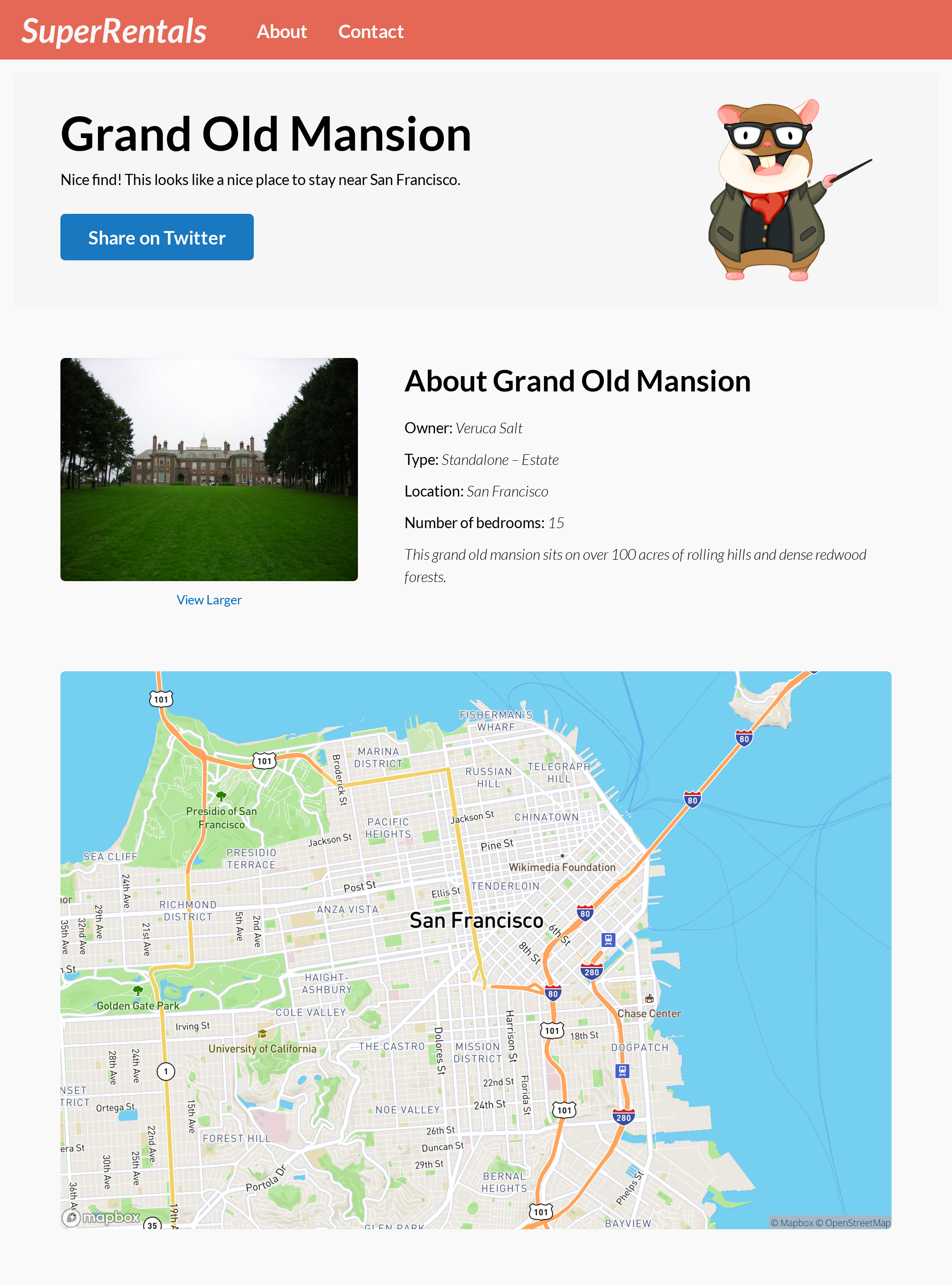
While adding these rental pages, you will learn about:
- Routes with dynamic segments
- Links with dynamic segments
- Component tests with access to the router
- Accessing parameters from dynamic segments
- Sharing common setup code between tests
Routes with Dynamic Segments
It would be great for our individual rental pages to be available through predictable URLs like /rentals/grand-old-mansion. Also, since these pages are dedicated to individual rentals, we can show more detailed information about each property on this page. It would also be nice to be able to have a way to bookmark a rental property, and share direct links to each individual rental listing so that our users can come back to these pages later on, after they are done browsing.
But first things first: we need to add a route for this new page. We can do that by adding a rental route to the router.
import EmberRouter from '@ember/routing/router';
import config from 'super-rentals/config/environment';
export default class Router extends EmberRouter {
location = config.locationType;
rootURL = config.rootURL;
}
Router.map(function () {
this.route('about');
this.route('contact', { path: '/getting-in-touch' });
this.route('rental', { path: '/rentals/:rental_id' });
});Notice that we are doing something a little different here. Instead of using the default path (/rental), we're specifying a custom path. Not only are we using a custom path, but we're also passing in a :rental_id, which is what we call a dynamic segment. When these routes are evaluated, the rental_id will be substituted with the id of the individual rental property that we are trying to navigate to.
Links with Dynamic Segments
Now that we have this route in place, we can update our <Rental> component to actually link to each of our detailed rental properties!
<article class="rental">
<Rental::Image
src={{@rental.image}}
alt="A picture of {{@rental.title}}"
/>
<div class="details">
<h3>{{@rental.title}}</h3>
<h3>
<LinkTo @route="rental" @model={{@rental}}>// [!code ++]
{{@rental.title}}
</LinkTo>// [!code ++]
</h3>// [!code ++]
<div class="detail owner">
<span>Owner:</span> {{@rental.owner}}
</div>
<div class="detail type">
<span>Type:</span> {{@rental.type}}
</div>
<div class="detail location">
<span>Location:</span> {{@rental.city}}
</div>
<div class="detail bedrooms">
<span>Number of bedrooms:</span> {{@rental.bedrooms}}
</div>
</div>
<Map
@lat={{@rental.location.lat}}
@lng={{@rental.location.lng}}
@zoom="9"
@width="150"
@height="150"
alt="A map of {{@rental.title}}"
/>
</article>Since we know that we're linking to the rental route that we just created, we also know that this route requires a dynamic segment. Thus, we need to pass in a @model argument so that the <LinkTo> component can generate the appropriate URL for that model.
Let's see this in action. If we go back to our browser and refresh the page, we should see our links, but something isn't quite right yet!

The links are all pointing to /rentals/undefined. Yikes! This is because <LinkTo> tries to use the id property from our model in order to replace the dynamic segment and generate the URL.
So what's the problem here? Well, our model doesn't actually have an id property! So of course the <LinkTo> component isn't going to be able to find it and use it to generate the URL. Oops!
Thankfully, we can fix this pretty easily. As it turns out, the data that is returned by our server—the JSON data that lives in our public/api folder—actually does have an id attribute on it. We can double check this by going to http://localhost:4200/api/rentals.json.
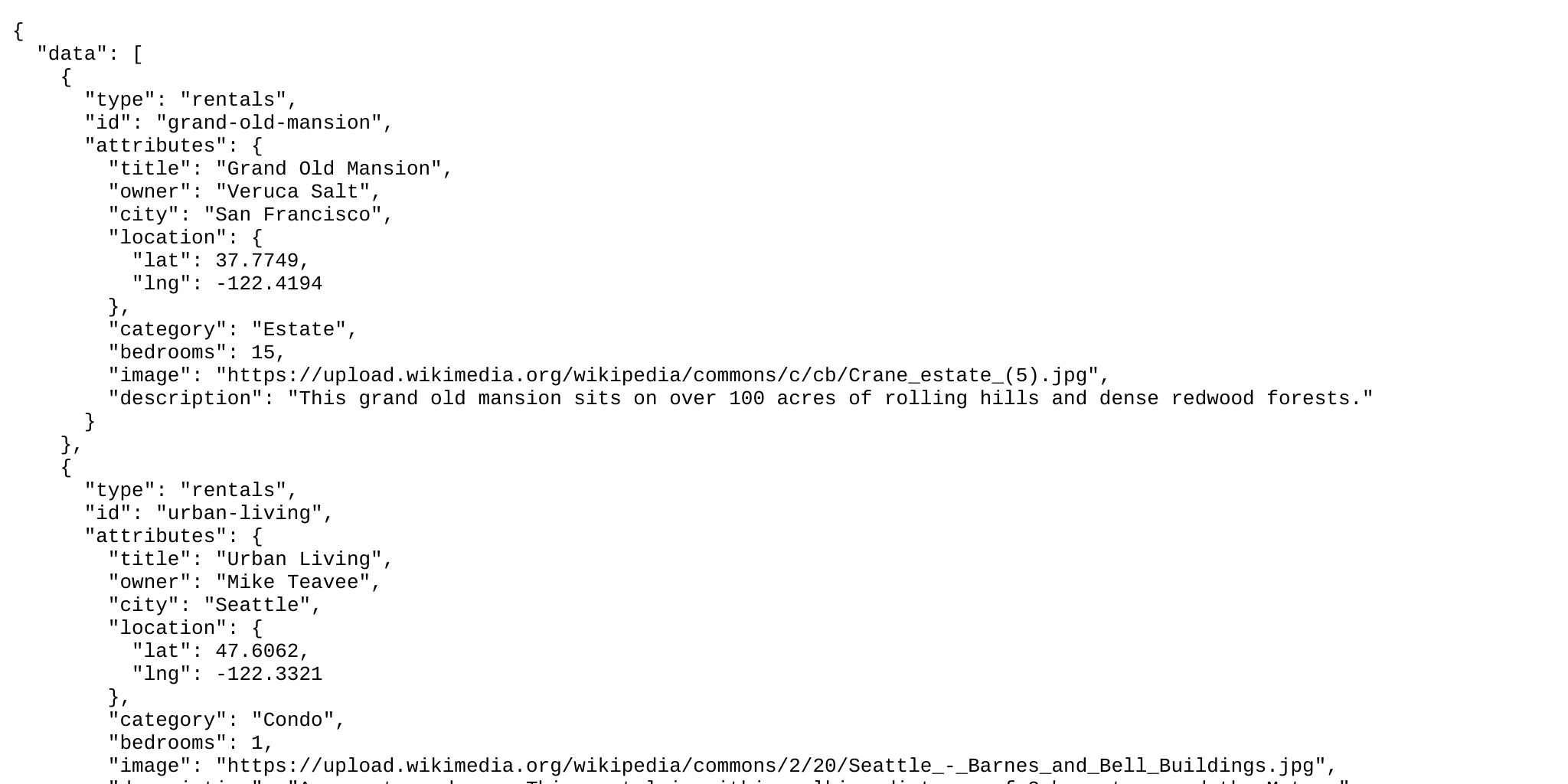
If we look at the JSON data here, we can see that the id is included right alongside the attributes key. So we have access to this data; the only trouble is that we're not including it in our model! Let's change our model hook in the index route so that it includes the id.
import Route from '@ember/routing/route';
const COMMUNITY_CATEGORIES = ['Condo', 'Townhouse', 'Apartment'];
export default class IndexRoute extends Route {
async model() {
let response = await fetch('/api/rentals.json');
let { data } = await response.json();
return data.map((model) => {
let { attributes } = model;
let { id, attributes } = model;
let type;
if (COMMUNITY_CATEGORIES.includes(attributes.category)) {
type = 'Community';
} else {
type = 'Standalone';
}
return { type, ...attributes };
return { id, type, ...attributes };
});
}
}Now that we've included our model's id, we should see the correct URLs to each rental property on our index page after refreshing the page.
Component Tests with Access to the Router
Alright, we have just one more step left here: updating the tests. We can add an id to the rental that we defined in our test using setProperties and add an assertion for the expected URL, too.
import { module, test } from 'qunit';
import { setupRenderingTest } from 'ember-qunit';
import { render } from '@ember/test-helpers';
import { hbs } from 'ember-cli-htmlbars';
module('Integration | Component | rental', function (hooks) {
setupRenderingTest(hooks);
test('it renders information about a rental property', async function (assert) {
this.setProperties({
rental: {
id: 'grand-old-mansion',
title: 'Grand Old Mansion',
owner: 'Veruca Salt',
city: 'San Francisco',
location: {
lat: 37.7749,
lng: -122.4194,
},
category: 'Estate',
type: 'Standalone',
bedrooms: 15,
image:
'https://upload.wikimedia.org/wikipedia/commons/c/cb/Crane_estate_(5).jpg',
description:
'This grand old mansion sits on over 100 acres of rolling hills and dense redwood forests.',
},
});
await render(hbs`<Rental @rental={{this.rental}} />`);
assert.dom('article').hasClass('rental');
assert.dom('article h3').hasText('Grand Old Mansion');
assert
.dom('article h3 a')
.hasAttribute('href', '/rentals/grand-old-mansion');
assert.dom('article .detail.owner').includesText('Veruca Salt');
assert.dom('article .detail.type').includesText('Standalone');
assert.dom('article .detail.location').includesText('San Francisco');
assert.dom('article .detail.bedrooms').includesText('15');
assert.dom('article .image').exists();
assert.dom('article .map').exists();
});
});If we run the tests in the browser, everything should just pass!
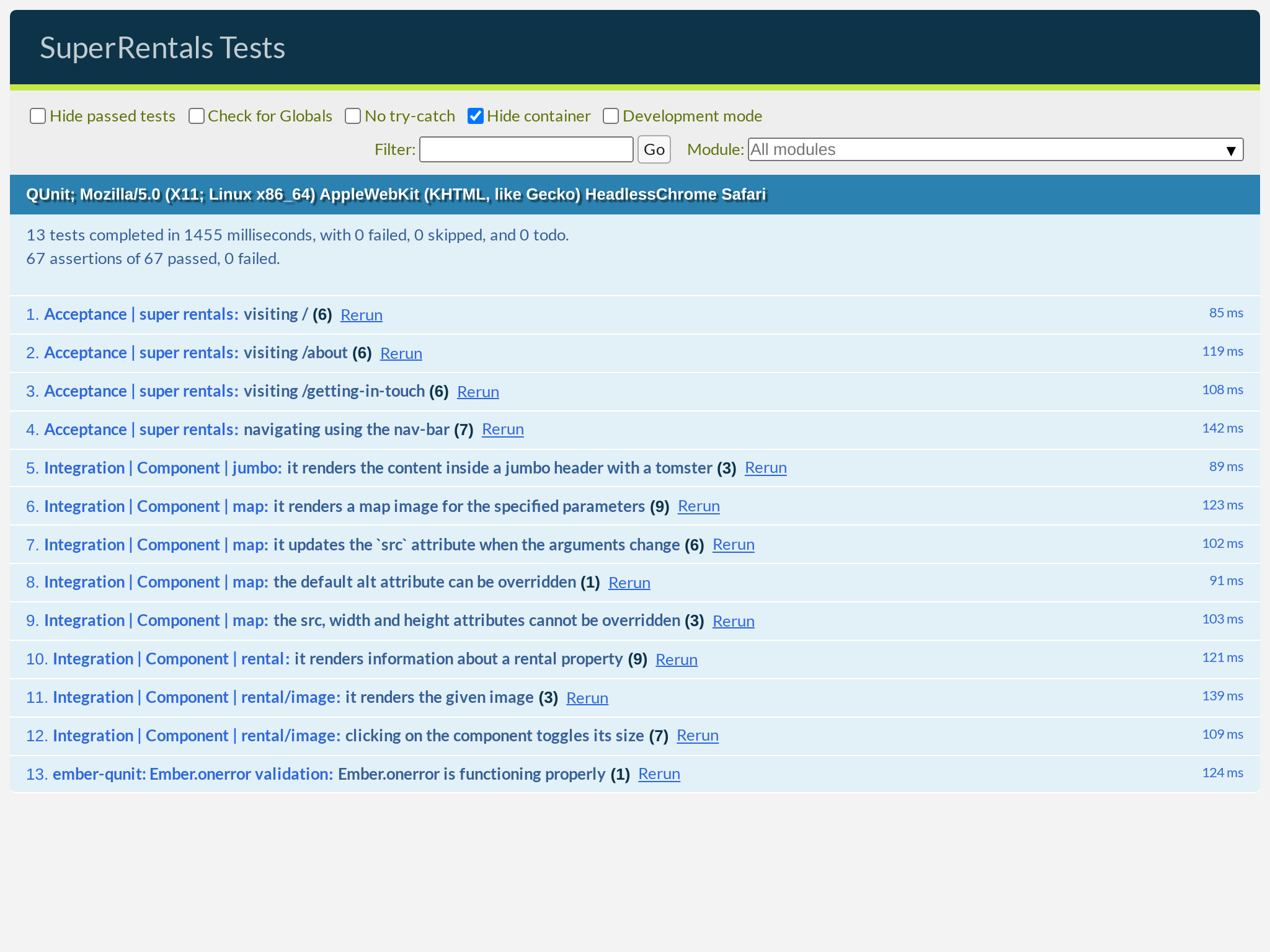
Accessing Parameters from Dynamic Segments
Awesome! We're making such great progress.
Now that we have our rental route, let's finish up our rental page. The first step to doing this is making our route actually do something. We added the route, but we haven't actually implemented it. So let's do that first by creating the route file.
import Route from '@ember/routing/route';
const COMMUNITY_CATEGORIES = ['Condo', 'Townhouse', 'Apartment'];
export default class RentalRoute extends Route {
async model(params) {
let response = await fetch(`/api/rentals/${params.rental_id}.json`);
let { data } = await response.json();
let { id, attributes } = data;
let type;
if (COMMUNITY_CATEGORIES.includes(attributes.category)) {
type = 'Community';
} else {
type = 'Standalone';
}
return { id, type, ...attributes };
}
}We'll notice that the model hook in our RentalRoute is almost the same as our IndexRoute. There is one major difference between these two routes, and we can see that difference reflected here.
Unlike the IndexRoute, we have a params object being passed into our model hook. This is because we need to fetch our data from the /api/rentals/${id}.json endpoint, not the /api/rentals.json endpoint we were previously using. We already know that the individual rental endpoints fetch a single rental object, rather than an array of them, and that the route uses a /:rental_id dynamic segment to figure out which rental object we're trying to fetch from the server.
But how does the dynamic segment actually get to the fetch function? Well, we have to pass it into the function. Conveniently, we have access to the value of the /:rental_id dynamic segment through the params object. This is why we have a params argument in our model hook here. It is being passed through to this hook, and we use the params.rental_id attribute to figure out what data we want to fetch.
Other than these minor differences though, the rest of the route is pretty much the same to what we had in our index route.
Displaying Model Details with a Component
Next, let's make a <Rental::Detailed> component.
$ ember generate component rental/detailed
installing component
create app/components/rental/detailed.hbs
skip app/components/rental/detailed.js
tip to add a class, run `ember generate component-class rental/detailed`
installing component-test
create tests/integration/components/rental/detailed-test.js{{yield}}
<Jumbo>
<h2>{{@rental.title}}</h2>
<p>Nice find! This looks like a nice place to stay near {{@rental.city}}.</p>
<a href="#" target="_blank" rel="external nofollow noopener noreferrer" class="share button">
Share on Twitter
</a>
</Jumbo>
<article class="rental detailed">
<Rental::Image
src={{@rental.image}}
alt="A picture of {{@rental.title}}"
/>
<div class="details">
<h3>About {{@rental.title}}</h3>
<div class="detail owner">
<span>Owner:</span> {{@rental.owner}}
</div>
<div class="detail type">
<span>Type:</span> {{@rental.type}} – {{@rental.category}}
</div>
<div class="detail location">
<span>Location:</span> {{@rental.city}}
</div>
<div class="detail bedrooms">
<span>Number of bedrooms:</span> {{@rental.bedrooms}}
</div>
<div class="detail description">
<p>{{@rental.description}}</p>
</div>
</div>
<Map
@lat={{@rental.location.lat}}
@lng={{@rental.location.lng}}
@zoom="12"
@width="894"
@height="600"
alt="A map of {{@rental.title}}"
class="large"
/>
</article>This component is similar to our <Rental> component, except for the following differences.
- It shows a banner with a share button at the top (Implementation to come later).
- It shows a bigger image by default, with some additional detailed information.
- It shows a bigger map.
- It shows a description.
Sharing Common Setup Code Between Tests
Now that we have this template in place, we can add some tests for this new component of ours.
import { module, test } from 'qunit';
import { setupRenderingTest } from 'ember-qunit';
import { render } from '@ember/test-helpers';
import { hbs } from 'ember-cli-htmlbars';
module('Integration | Component | rental/detailed', function (hooks) {
setupRenderingTest(hooks);
test('it renders', async function (assert) {
// Set any properties with this.set('myProperty', 'value');
// Handle any actions with this.set('myAction', function(val) { ... });
hooks.beforeEach(function () {
this.setProperties({
rental: {
id: 'grand-old-mansion',
title: 'Grand Old Mansion',
owner: 'Veruca Salt',
city: 'San Francisco',
location: {
lat: 37.7749,
lng: -122.4194,
},
category: 'Estate',
type: 'Standalone',
bedrooms: 15,
image:
'https://upload.wikimedia.org/wikipedia/commons/c/cb/Crane_estate_(5).jpg',
description:
'This grand old mansion sits on over 100 acres of rolling hills and dense redwood forests.',
},
});
});
await render(hbs`<Rental::Detailed />`);
test('it renders a header with a share button', async function (assert) {
await render(hbs`<Rental::Detailed @rental={{this.rental}} />`);
assert.dom(this.element).hasText('');
assert.dom('.jumbo').exists();
assert.dom('.jumbo h2').containsText('Grand Old Mansion');
assert
.dom('.jumbo p')
.containsText('a nice place to stay near San Francisco');
assert.dom('.jumbo a.button').containsText('Share on Twitter');
});
// Template block usage:
await render(hbs`
<Rental::Detailed>
template block text
</Rental::Detailed>
`);
test('it renders detailed information about a rental property', async function (assert) {
await render(hbs`<Rental::Detailed @rental={{this.rental}} />`);
assert.dom(this.element).hasText('template block text');
assert.dom('article').hasClass('rental');
assert.dom('article h3').containsText('About Grand Old Mansion');
assert.dom('article .detail.owner').containsText('Veruca Salt');
assert.dom('article .detail.type').containsText('Standalone – Estate');
assert.dom('article .detail.location').containsText('San Francisco');
assert.dom('article .detail.bedrooms').containsText('15');
assert.dom('article .image').exists();
assert.dom('article .map').exists();
});
});We can use the beforeEach hook to share some boilerplate code, which allows us to have two tests that each focus on a different, single aspect of the component. This feels similar to other tests that we've already written—hopefully it feels easy, too!

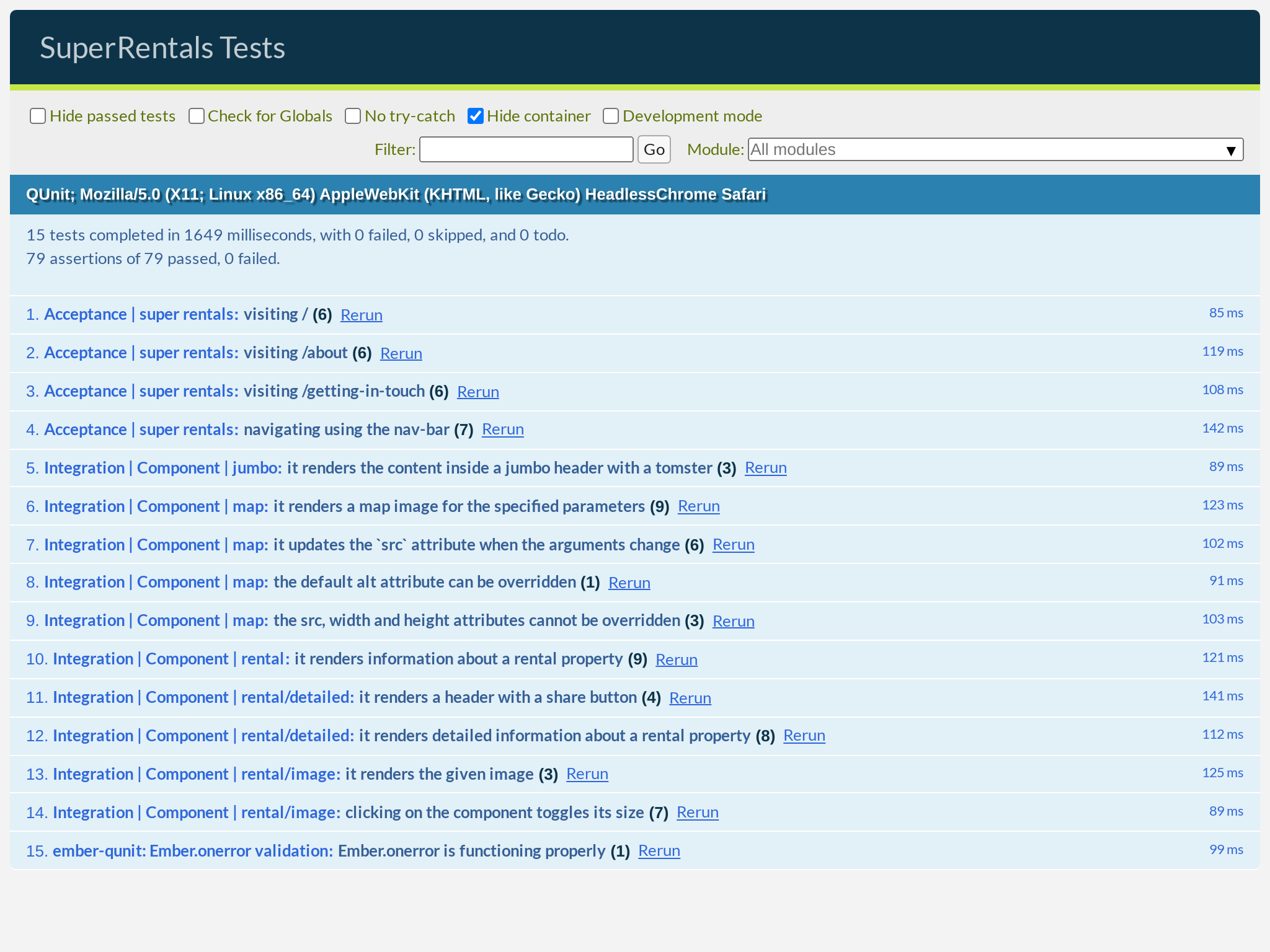
Adding a Route Template
Finally, let's add a rental template to actually invoke our <Rental::Detailed> component, as well as adding an acceptance test for this new behavior in our app.
<Rental::Detailed @rental={{@model}} />import { module, test } from 'qunit';
import { click, visit, currentURL } from '@ember/test-helpers';
import { setupApplicationTest } from 'ember-qunit';
module('Acceptance | super rentals', function (hooks) {
setupApplicationTest(hooks);
test('visiting /', async function (assert) {
await visit('/');
assert.equal(currentURL(), '/');
assert.dom('nav').exists();
assert.dom('h1').hasText('SuperRentals');
assert.dom('h2').hasText('Welcome to Super Rentals!');
assert.dom('.jumbo a.button').hasText('About Us');
await click('.jumbo a.button');
assert.equal(currentURL(), '/about');
});
test('viewing the details of a rental property', async function (assert) {
await visit('/');
assert.dom('.rental').exists({ count: 3 });
await click('.rental:first-of-type a');
assert.equal(currentURL(), '/rentals/grand-old-mansion');
});
test('visiting /rentals/grand-old-mansion', async function (assert) {
await visit('/rentals/grand-old-mansion');
assert.equal(currentURL(), '/rentals/grand-old-mansion');
assert.dom('nav').exists();
assert.dom('h1').containsText('SuperRentals');
assert.dom('h2').containsText('Grand Old Mansion');
assert.dom('.rental.detailed').exists();
});
test('visiting /about', async function (assert) {
await visit('/about');
assert.equal(currentURL(), '/about');
assert.dom('nav').exists();
assert.dom('h1').hasText('SuperRentals');
assert.dom('h2').hasText('About Super Rentals');
assert.dom('.jumbo a.button').hasText('Contact Us');
await click('.jumbo a.button');
assert.equal(currentURL(), '/getting-in-touch');
});
test('visiting /getting-in-touch', async function (assert) {
await visit('/getting-in-touch');
assert.equal(currentURL(), '/getting-in-touch');
assert.dom('nav').exists();
assert.dom('h1').hasText('SuperRentals');
assert.dom('h2').hasText('Contact Us');
assert.dom('.jumbo a.button').hasText('About');
await click('.jumbo a.button');
assert.equal(currentURL(), '/about');
});
test('navigating using the nav-bar', async function (assert) {
await visit('/');
assert.dom('nav').exists();
assert.dom('nav a.menu-index').hasText('SuperRentals');
assert.dom('nav a.menu-about').hasText('About');
assert.dom('nav a.menu-contact').hasText('Contact');
await click('nav a.menu-about');
assert.equal(currentURL(), '/about');
await click('nav a.menu-contact');
assert.equal(currentURL(), '/getting-in-touch');
await click('nav a.menu-index');
assert.equal(currentURL(), '/');
});
});Now, when we visit http://localhost:4200/rentals/grand-old-mansion, this is what we see:

And if we run our tests now...
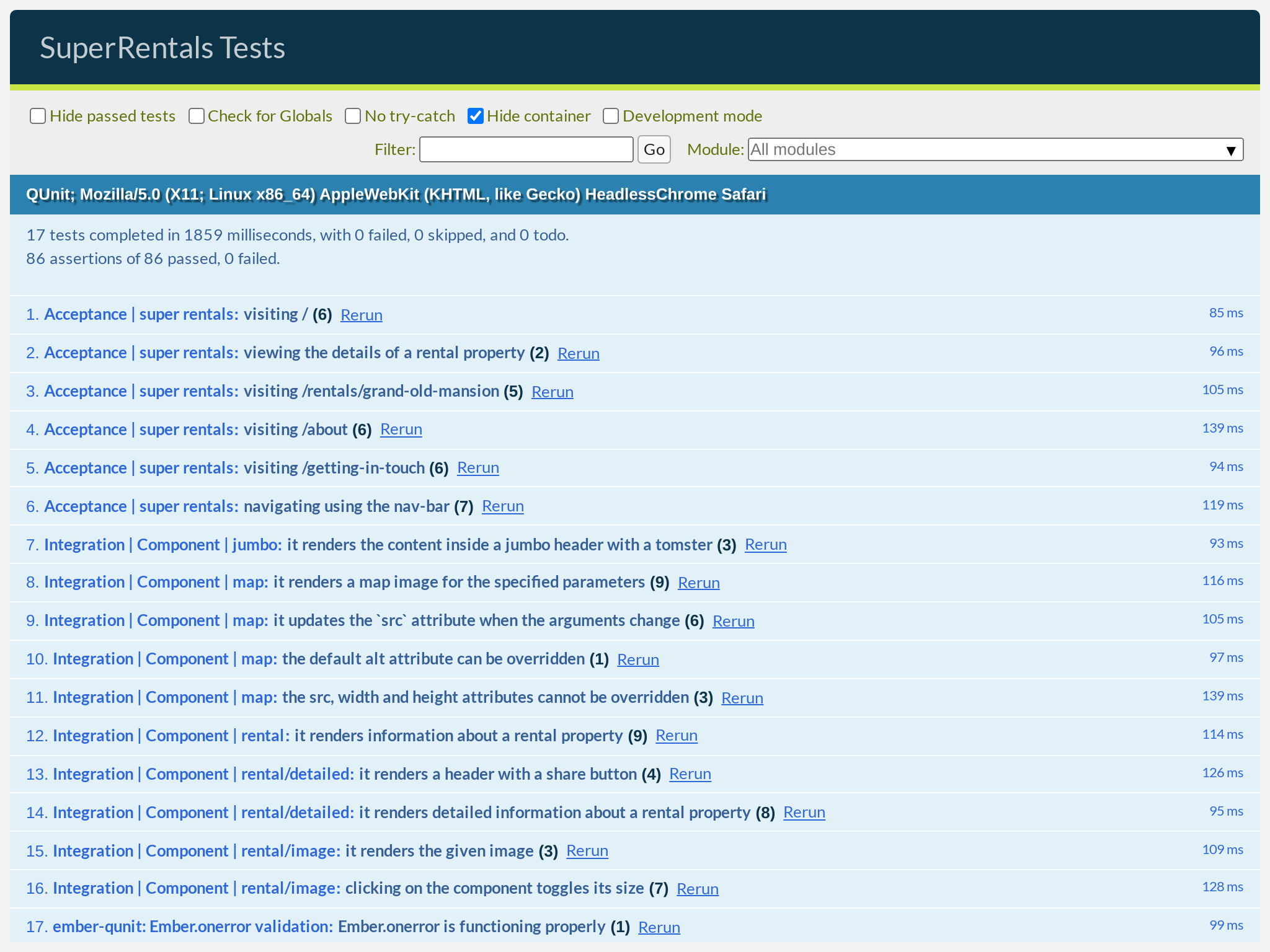
...they all pass! Great work!
This page looks done, but we have a share button that doesn't actually work. We'll address this in the next chapter.